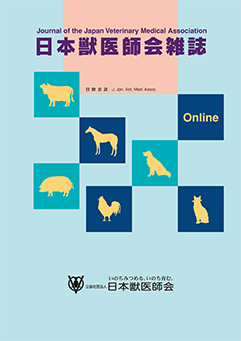
- |<
- <
- 1
- >
- >|
-
Megumi KAWAI, Michiko HAYASHI, Kazuaki TAKAHASHI, Tomoyuki SHIBAHARA, ...Article type: Original Article
2023Volume 76Issue 2 Pages e18-e27
Published: 2023
Released on J-STAGE: February 07, 2023
JOURNAL FREE ACCESSFive calves died at two farms in Ishikawa prefecture, Japan, in 2020. Pathological examinations revealed that these calves may have been infected with Cryptosporidium spp. PCR of 18S rRNA genes and a multiplex PCR of actin genes identified two genotypes of Cryptosporidium parvum, type 1 and type 2, which included 3 bp deletions and 2 bp substitutions, in all calves. This is the first report of mixed infections with multiple genotypes of Cryptosporidium. C. bovis and C. ryanae were also detected in other calves reared at the same farms. Environmental examinations of the farms by PCR revealed that Cryptosporidium spp. were present only in the rice husks that were used as bedding litter. The rate of animals with diarrhea was reduced by treating the areas in which the calves were reared with boiling water and milk of lime. However, the infections could not be completely eliminated.
View full abstractDownload PDF (1011K) -
Terunori KOREEDA, Yusuke ABETO, Makoto MATSUBAYASHI, Tomoyuki SHIBAHAR ...Article type: Review
2023Volume 76Issue 2 Pages e37-e44
Published: 2023
Released on J-STAGE: February 10, 2023
JOURNAL FREE ACCESSDownload PDF (2585K)
-
Mayumi TSUKAMOTO, Toshihiro KARIYA, Tatsuya YAMAZAKI, Urara OBATA, Kos ...Article type: Original Article
2023Volume 76Issue 2 Pages e11-e17
Published: 2023
Released on J-STAGE: February 03, 2023
JOURNAL FREE ACCESSTo confirm the usefulness of Zero Tolerance Verification at a slaughterhouse, we collected surface samples of beef carcass contaminated with animal hair (5 samples), feces (8 samples), gastrointestinal contents (6 samples), rail dust (5 samples), and foot cutter residue (5 samples). The aerobic bacteria counts (ABCs) (mean±standard deviation) of samples contaminated with animal hair, feces, gastrointestinal contents, rail dust, and foot cutter residue were 3.27 ± 1.23, 4.37 ± 1.83, 4.20 ± 0.90, 1.04 ± 0.58, and 1.70 ± 0.23 log cfu/cm2, respectively, while the Enterobacteriaceae counts (mean ± SD) of samples contaminated with animal hair, feces, and gastrointestinal contents were 1.40 ± 0.73, 2.22 ± 0.93, and 2.12 ± 1.35 log cfu/cm2, respectively. No Enterobacteriaceae were found in the samples contaminated with rail dust or foot cutter residue. There were no significant differences of ABCs and Enterobacteriaceae counts between animal hair, feces, and gastrointestinal contents. ABCs of the hair-feces-gastrointestinal contents samples was statistically higher (P<0.05) than that of rail dust-foot cutter samples. Bacteria from the phylum Firmicutes were the most common in samples contaminated with gastrointestinal contents, whereas those from the phylum Proteobacteria were the most common in those contaminated with animal hair, rail dust, and foot cutter residue. Both phylum Firmicutes and Proteobacteria were common in fecal samples. The results suggest the necessity of removing not only gastrointestinal contents and feces but also animal hair from the surface of carcasses in slaughterhouses.
View full abstractDownload PDF (1204K) -
Yoshimi MATSUZAWA, Kanae TSUZUKIArticle type: Original Article
2023Volume 76Issue 2 Pages e28-e36
Published: 2023
Released on J-STAGE: February 10, 2023
JOURNAL FREE ACCESSThe Animal Welfare Center in X Prefecture has been supporting children refusing to go to school using animal assisted therapy as a “safe place”. As the intervention sessions progressed, there were changes in the spontaneous behavior of the children who are staying at home such as children refusing to go to school and hikikomori. In order to evaluate the effectiveness of animal assisted therapy, we calculated the size of the effect using the visually observed behavior of children as an index. Based on the interpretive criteria of the percentage of non-overlapping data (PND) which is an effect index in the statistical analysis of single-case experimental designs, the evaluation showed that there were effective changes in 20 of the 27 subjects. The size of the effect tended to be larger when the child and animal had a mutually beneficial relationship and when the child performed useful tasks for the animal.
View full abstractDownload PDF (805K)
- |<
- <
- 1
- >
- >|